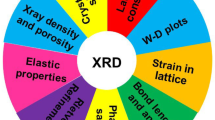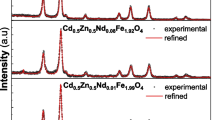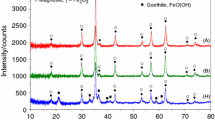Abstract
Single-crystal and powder electron paramagnetic resonance (EPR) spectroscopic studies of natural amethyst quartz, before and after isochronal annealing between 573 and 1,173 K, have been made from 90 to 294 K. Single-crystal EPR spectra confirm the presence of two substitutional Fe3+ centers. Powder EPR spectra are characterized by two broad resonance signals at g = ~10.8 and 4.0 and a sharp signal at g = 2.002. The sharp signal is readily attributed to the well-established oxygen vacancy electron center E 1′. However, the two broad signals do not correspond to any known Fe3+ centers in the quartz lattice, but are most likely attributable to Fe3+ clusters on surfaces. The absolute numbers of spins of the Fe3+ species at g = ~10.8 have been calculated from powder EPR spectra measured at temperatures from 90 to 294 K. These results have been used to extract thermodynamic potentials, including Gibbs energy of activation ΔG, activation energy E a, entropy of activation ΔS and enthalpy of activation ΔH for the Fe3+ species in amethyst. In addition, magnetic susceptibilities (χ) have been calculated from EPR data at different temperatures. A linear relationship between magnetic susceptibility and temperature is consistent with the Curie–Weiss law. Knowledge about the stability and properties of Fe3+ species on the surfaces of quartz is important to better understanding of the reactivity, bioavailability and heath effects of iron in silica particles.






Similar content being viewed by others
References
Balitsky VS, Machina IB, Marin AA, Shigley JE, Rossman GR, Lu T (2000) Industrial growth, morphology and some properties of bi-colored amethyst citrine quartz (ametrine). J Crystal Growth 212:255–260
Barry TG, McNamara P, Moore WJ (1965) Paramagnetic resonance and optical properties of amethyst. J Chem Phys 7:2599–2606
Borgheresi M, Di Benedetto F, Caneschi A, Pratesi G, Romanelli M, Sorace L (2007) An EPR and SQUID magnetometry study of bornite. Phys Chem Miner 34:609–619
Bramley R, McCool MB (1976) EPR of Fe3+ pairs in α-Al2O3. J Phys C Solid State Phys 9:1793–1806
Carbonaro CM, Fiorentini V, Berardini F (2001) Proof of the thermodynamical stability of the E’ center in SiO2. Phys Rev Lett 86:3064–3067
Chakradhar RPS, Murali A, Rao JL (1998) Electron paramagnetic resonance and optical absorption studies of Fe(III) ions in alkali barium borate glasses. Opt Mater 10:109–116
Chakradhar RPS, SivaRamaiah G, Rao JL, Gopal NO (2005) Fe3+ ions in alkali lead tetraborate glasses—an electron paramagnetic resonance and optical study. Spectrochem Acta Part A 62:51–57
Cohen AJ (1985) Amethyst color in quartz, the result of radiation protection involving iron. Am Mineral 70:1180–1185
Cortezão SU, Pontuschka WM, Da Rocha MSF, Blak AR (2003) Depolarisation currents (TSDC) and paramagnetic resonance (EPR) of iron in amethyst. J Phys Chem Solids 64:1151–1155
Cox RT (1976) EPR of an S = 2 centre in amethyst quartz and its possible identification as the d4 ion Fe4+. J Phys C Solid State Phys 9:3355–3361
Cox RT (1977) Optical absorption of the d4 ion Fe4+ in pleochroic amethyst quartz. J Phys C Solid State Phys 10:4631–4643
Cressey G, Henderson CMB, van der Laan G (1993) Use of L-edge X-ray absorption spectroscopy to characterize multiple valence states of 3d transition metals; a new probe for mineralogical and geochemical research. Phys Chem Miner 20:111–119
Dedushenko SK, Makhina IB, Marin AA, Mukhanov VA, Perfiliev YD (2004) What oxidation state of iron determines the amethyst colour? Hyperfine Interact 156(157):417–422
Di Benedetto F, Innocenti M, Tesi S, Romanelli M, D’Acapito F, Fornaciai G, Montegrossi G, Pardi LA (2010) A Fe K-edge XAS study of amethyst. Phys Chem Miner 37:283–289
Donaldson K, Borm PJA (1998) The quartz hazard: a variable entity. Ann Occup Hyg 42:287–294
Feigl FJ, Flower BW, Yip KL (1974) Oxygen vacancy model in the E’ center in SiO2. Solid State Commun 14:225–229
Fubini B, Fenogli I (2007) Toxic potential of mineral dusts. Elements 3:407–416
Gaite JM, Ermakoff P, Allard TH, Muller JP (1997) Paramagnetic Fe3+: a sensitive probe for disorder in kaolinite. Clays Clay Miner 45:496–505
Golding RM, Kestigian M, Tennant CW (1978) EPR of high-spin Fe3+ in calcium tungstate. J Phys C Solid State Phys 11:5041–5049
Gopal NO, Narasimhulu KV, Lakshmana Rao JL (2004) Optical absorption, EPR, infrared and Raman spectral studies of clinochlore mineral. J Phys Chem Solids 65:1887–1893
Halliburton LE, Hantehzadeh MR, Minge J, Mombourquette MJ, Weil JA (1989) EPR study of Fe3+ in alpha quartz: a reexamination of the lithium-compensated center. Phys Rev B40:2076–2081
Han CS, Choh SH (1989) EPR study of iron centers in natural amethyst. J Korean Phys Soc 22:241–252
Hemantha Kumar GN, Parthasarathy G, Chakradhar RPS, Rao JL, Ratnakaram YC (2010) Temperature dependence on the electron paramagnetic resonance spectra of natural jasper from Taroko Gorge (Taiwan). Phys Chem Miner 37:201–208
Hofmeister AM, Rossman GR (1984) Determination of Fe3+ and Fe2+ concentrations in feldspar by optical absorption and EPR spectroscopy. Phys Chem Miner 11:213–224
Hovis GL (1988) Enthalpies and volumes related to K–Na mixing and Al–Si order/disorder in alkali feldspars. J Petrol 29(4):731–763
Hrouda F (1986) The effect of quartz on the magnetic anisotropy of quartzite. Studia Geophys Geodaet 30:39–45
Hutton DR, Troup DJ (1966) Paramagnetic resonance centres in amethyst and citrine quartz. Nature 211:621
Jani MG, Bossoli RB, Halliburton LE (1983) Further characterization of the E1’ center in crystalline SiO2. Phys Rev B27:2285–2293
Lehmann G, Bambauer H (1973) Quartz crystals and their colors. Angew Chem 85:281–289
Lehmann G, Moore WJ (1966) Color center in amethyst quartz. Science 152:1061–1062
Matarrese LM, Weil JA, Peterson RL (1969) EPR spectrum of Fe3+ in synthetic brown quartz. J Chem Phys 50:2350–2360
Minge J, Weil JA, McGavin DG (1989) EPR study of Fe3+ in α-quartz: characterization of a new type of cation-compensated center. Phys Rev B 40:6490
Minge J, Mombourquette MJ, Weil JA (1990) EPR study of Fe3+ in α-quartz: the sodium-compensated center. Phys Rev B42:33–36
Mombourquette MJ, Tennant WC, Weil JA (1986) EPR study of Fe3+ in α-quartz: a reexamination of the so-called I center. J Chem Phys 86:68–79
Murali A, Rao JL (1999) Spectroscopic investigations on Cu(II) ions doped in alkali lead borotellurite glasses. J Phys Condens Matter 11:7921–7935
Polikreti K, Maniatis Y (2004) Distribution changes of Mn2+ and Fe3+ on weathered marble surfaces measured by EPR spectroscopy. Atmos Environ 38:3617–3624
Rager H, Schneider H (1986) EPR study of Fe3+ centers in crystobalite and tridymite. Am Mineral 71:105–110
Samarth N, Furdyna JK (1988) A proposed interpretation of the EPR linewidth in diluted magnetic semiconductors. Solid State Commun 65:801–804
Santillan-Medrano JM, Bohn Hinrich L (1972) Measurements of the standard entropy of formation of clay minerals. Soil Sci Soc Am J 36:835–838
Schofield PF, Henderson CMB, Cressey G, van der Laan G (1995) 2p X-ray absorption spectroscopy in the earth sciences. J Synchrotron Radiat 2:93–98
Thompson AB (1974) Gibbs energy of aluminous minerals. Contrib Mineral Petrol 48:123–136
Weil JA (1984) A review of electron spin spectroscopy and its application to the study of paramagnetic defects in crystalline quartz. Phys Chem Miner 10:149–165
Weil JA, Bolton JR (2007) Electron paramagnetic resonance: elementary theory and practical applications. Wiley, New York
Yoo SJ, Hu Z, Goh C, Bominaar EL, Holm RH, Munck E (1997) Determination of the exchange-coupling constant of an Fe3+–Fe3+ pair in a cubane-type iron–sulfur cluster. J Am Chem Soc 119:8732–8733
Zhang X, Guo H, Chi N, Wang SC, Yang NL, Akins DL (2006) Self aligned magnetic dipole moments of Fe2O3 formed within sol–gel matrix. Mater Chem Phys 98:207–211
Acknowledgments
We thank Dr Milan Rieder and the two anonymous referees for incisive criticisms and helpful suggestions, Dr KV Narasimhulu and Prof. JL Rao for helpful discussions, Dr Satya Singh for provision of CuSO4·5H2O, and the Natural Science and Engineering Research Council (NSERC) of Canada for financial support.
Author information
Authors and Affiliations
Corresponding author
Rights and permissions
About this article
Cite this article
SivaRamaiah, G., Lin, J. & Pan, Y. Electron paramagnetic resonance spectroscopy of Fe3+ ions in amethyst: thermodynamic potentials and magnetic susceptibility. Phys Chem Minerals 38, 159–167 (2011). https://doi.org/10.1007/s00269-010-0391-2
Received:
Accepted:
Published:
Issue Date:
DOI: https://doi.org/10.1007/s00269-010-0391-2




